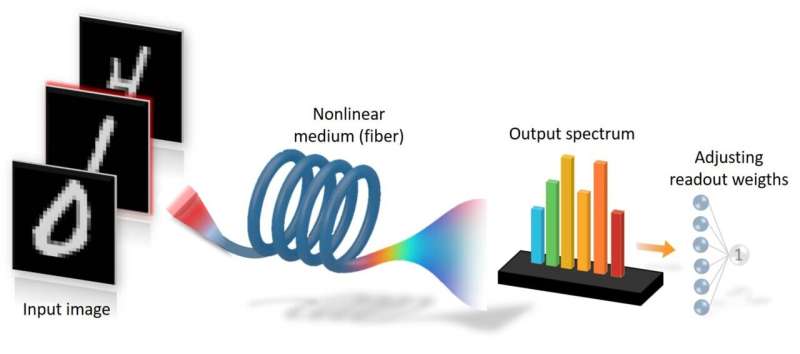Light-based computing with optical fibers shows potential for ultra-fast AI systems
A groundbreaking collaboration between research teams from Finland and France has showcased a new method of information processing using light and optical fibers. This innovative approach could pave the way for the development of ultra-fast computers that outperform traditional electronic systems. The studies detailing this advancement have been published in Optics Letters and on the arXiv preprint server, highlighting the potential for significant technological advancements in computing. This research represents a significant step towards harnessing light-based processing for more efficient and rapid computation. The use of light in computing could revolutionize the speed and efficiency of data processing, leading to transformative advancements in technology.

June 18, 2025 by Tampere University edited by Gaby Clark, reviewed by Robert Egan, scientific editor, associate editor
A Novel Approach to Computing with Light
This article highlights a groundbreaking collaboration between research teams from Tampere University in Finland and Université Marie et Louis Pasteur in France, demonstrating a new method of processing information using light and optical fibers. This innovation holds the potential to revolutionize computing by enabling the development of ultra-fast computers. The studies showcasing this advancement have been published in Optics Letters and on the arXiv preprint server.
Utilizing Light for Enhanced Computing
The research conducted by postdoctoral researchers Dr. Mathilde Hary from Tampere University and Dr. Andrei Ermolaev from Université Marie et Louis Pasteur focused on leveraging laser light within thin glass fibers to simulate the information processing capabilities of artificial intelligence (AI). Instead of conventional electronics and algorithms, the computation is achieved through the nonlinear interaction between intense light pulses and the glass material.
Traditional electronics are reaching their limits in terms of bandwidth, data throughput, and power consumption. On the other hand, optical fibers offer the ability to process data at speeds thousands of times faster and amplify minute differences through extreme nonlinear interactions.
Efficient Computing with Optical Fibers
In their recent work, the researchers demonstrated the functioning of an optical Extreme Learning Machine system by using femtosecond laser pulses and an optical fiber that confines light in an area smaller than a fraction of a human hair. By encoding images into the relative delay of different wavelengths of light sent into the fiber, the resulting spectrum at the fiber's output contained enough information to classify handwritten digits with an accuracy exceeding 91% in less than one picosecond.
The researchers emphasized that achieving optimal performance did not solely rely on maximizing power but also on the precise structuring of light and its interaction with the fiber properties. This delicate balance between fiber length, dispersion, and power levels was critical in attaining high accuracy levels.
Advancing Optical Nonlinearity in Computing
Both research teams involved in this collaboration are renowned for their expertise in nonlinear light-matter interactions. By merging physics and machine learning, they aim to develop new avenues for ultrafast and energy-efficient AI hardware that combine fundamental research in nonlinear fiber optics with cutting-edge computational approaches.
Their ultimate goal is to create on-chip optical systems capable of real-time operation outside laboratory settings, with potential applications spanning real-time signal processing, environmental monitoring, and high-speed AI inference.

